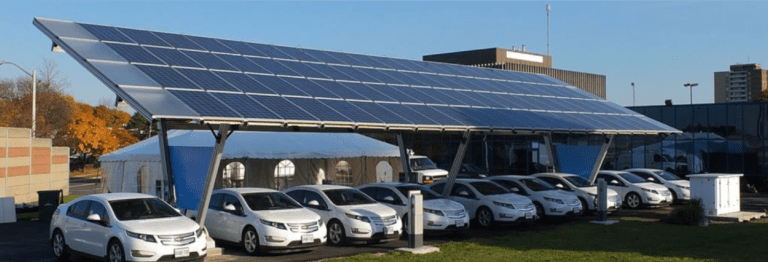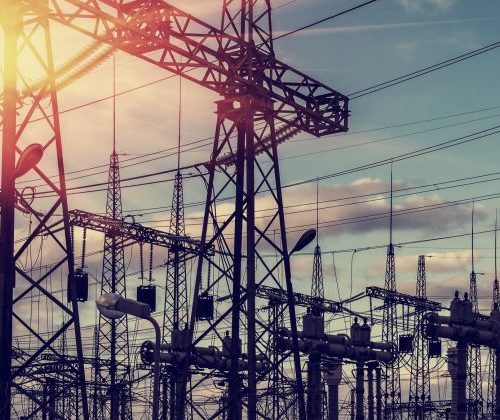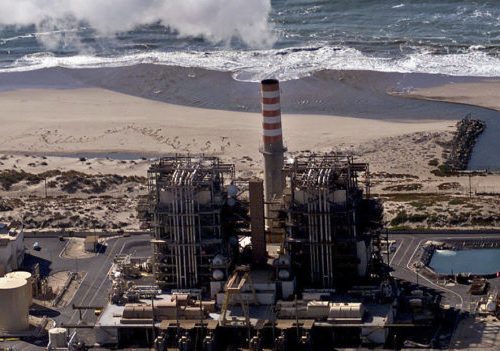The Best Ideas from COP30, the UN Climate Summit in Brazil – 18 December 2025
The Clean Coalition was a partner organization for this webinar, which took place on 18 December 2025 at 10am.
Read More
Designing and staging Community Microgrids with the goal of 25% local renewables by 2025
On this page:
The Clean Coalition designs and stages Community Microgrids and their building blocks, Solar Microgrids, to provide indefinite, renewables-driven backup power to critical facilities such as fire stations and emergency shelters — bringing communities unparalleled economic, environmental, and resilience benefits.
Our vision: Ultimately, the United States will be 100% powered by renewable energy. From 2025 onward, at least 25% of all electricity generated from newly added generation capacity in the United States will be from local renewable energy sources.
A Community Microgrid is a coordinated local grid area served by one or more distribution substations and supported by high penetrations of local renewables and other distributed energy resources (DER), such as energy storage and demand response. Community Microgrids represent a new approach for designing and operating the electric grid, relying heavily on DER to achieve a more sustainable, secure, and cost-effective energy system while providing indefinite, renewables-driven backup power for prioritized loads
The Goleta Load Pocket Community Microgrid (GLPCM) will showcase the power system of the future. The Goleta Load Pocket (GLP) is a 70-mile stretch of Southern California coastline, from Point Conception to Lake Casitas, encompassing the cities of Goleta, Santa Barbara (including Montecito), and Carpinteria. This disaster-prone, transmission-vulnerable region provides the perfect opportunity for a comprehensive Community Microgrid.

In the webinar below, presented on 25 July 2019, Clean Coalition Executive Director Craig Lewis provides an overview of the GLPCM and its goals, discusses why we need a Community Microgrid in the GLP, and covers the policies and market mechanisms needed to proliferate Community Microgrids.
As part of TEDCountdown, ReImagine Science presented TEDxReimagineScience on 24 October 2020, featuring four high-impact speakers whose work has caught their attention. In this video, the Clean Coalition’s Executive Director, Craig Lewis, shared energy grid designs that are attainable now — in a way that creates resilient energy sources in times of natural disasters and halts a deeper carbon footprint. The following video clip shows the beginning of the talk.
View the full video on YouTube here.
The technology we need for Solar Microgrids and Community Microgrids is available now. What limits their proliferation is monopoly-driven, archaic policy and a lack of the right market mechanisms. The Clean Coalition is working to change this through our policy and programs initiatives.

While everyone understands there is significant value to the resilience provided by indefinite renewables-driven backup power, the value of this unparalleled resilience has yet to be quantified — creating an economic gap for Community Microgrid projects.
The close this gap, the Clean Coalition is working to establish a standardized Value of Resilience (VOR123), allocating electric loads into three tiers:

The Clean Coalition has a long history of streamlining the interconnection process for wholesale distributed generation (WDG) — which is often commercial-scale solar and storage. Unleashing the underserved WDG market segment will bring much more clean local energy to our communities.
Highlights of our interconnection work:

With our Solar Siting Surveys, the Clean Coalition is showing the ample solar siting opportunities in urban areas on built environments like rooftops, parking lots, and parking structures.
To make solar procurement effective in these locations, the Clean Coalition designs state-of-the art Feed-in-Tariffs (FITs) — standardized, long-term, guaranteed contracts that allow renewable energy projects to sell power to the local utility or other load-serving entity. FITs like the one we designed for the City of San Diego include Market Responsive Pricing to ensure cost-effectiveness and a Dispatchability Adder to incentivize energy storage.
DER provide significant value in avoiding the need for new transmission infrastructure. This value is starting to be recognized by the California Public Utilities Commission (CPUC) in their Avoided Cost Calculator (ACC), which the CPUC uses to calculate the value of DER projects, programs, policies, and deployments, and to evaluate their cost-effectiveness.
But the ACC disregards cost allocations associated with existing transmission infrastructure. Currently, in California all energy in investor-owned utility (IOU) service territories is charged to use the transmission grid, whether or not that energy ever touches the transmission grid. This market distortion effectively steals 2 cents/kWh from DER. The Clean Coalition is leading a campaign to reform Transmission Access Charges (TAC) in California.

In addition to properly accounting for the value of DER in avoiding transmission costs, divesting California’s IOUs of their transmission assets is arguably the most effective single step that can be taken to ensure that get serious about renewables-driven resilience and Community Microgrids — and set the stage for the Distribution System Operator (DSO) future

Can Community Microgrids powered by solar+storage replace gas peaker plants? The answer is a resounding Yes.
In 2017, the Clean Coalition released a study showing that solar+storage would be cheaper than two proposed gas plant projects in California: the Puente Power Project and the Ellwood Peaker Plant. The projects are both part of the Moorpark Subarea, which includes the cities of Oxnard, Santa Barbara, and Goleta.

Developed in collaboration with a team of industry experts, the ECMR guidelines provide recommendations for the simple, inexpensive wiring and components needed to achieve full electrification and a Solar Microgrid — as well as the wiring and communications required for participating in a future Community Microgrid.
The ECMR guidelines are meant to enhance building codes and to assist homeowners, developers, and electrical engineers to easily plan and install the necessary wiring and communications to be all-electric and Community Microgrid Ready.
The latest in clean local energy
Learn about our innovative projects and initiatives on our blog, and see what others are reporting about our important work.
The Clean Coalition was a partner organization for this webinar, which took place on 18 December 2025 at 10am.
Read MoreThis podcast episode of Energy Central's "Power Perspectives" welcomes Craig Lewis, Founder and Executive Director of the Clean Coalition, to explore how local solar and storage can flatten the duck curve, cut costs, and build a more resilient grid.
Read MoreThe Clean Coalition presented during this in-person gathering, held on Friday, 5 December 2025 from 3:30–5:00 pm PST at CEC’s Environmental Hub, 1219 State St Suite A, Santa Barbara, CA 93101.
Read More